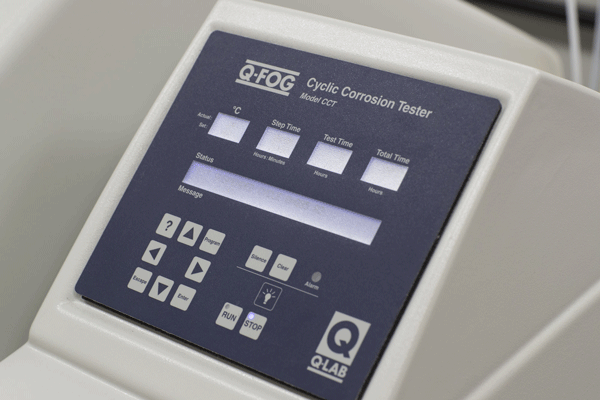A team of researchers at the University of Virginia (Charlottesville, Virginia)1 is working to improve the efficiency of cyclic corrosion test chambers, with a goal of supplying data to clients more quickly on the future corrosion risks of various metals.
Partnerships with major organizations such as Rolls-Royce (Derby, United Kingdom) have allowed the school to experiment with modifying and improving the test chamber—a commercial device used to test for corrosion through the manipulation of temperature, humidity, and salt.
Led by Robert Kelly (Figure 1), FNACE, an engineering professor at the school, the team recently altered the chamber by adding ozone to the mix and accelerating the process. The additions of ozone from a commercial ozone generator and ultraviolet (UV) light can help to recreate the corrosion observed in geolocations around the world, according to the researchers.
“Ozone is a good proxy for natural oxidizers, something that is missing in most accelerated tests,” Kelly says.
The modified chamber includes one subsystem that produces up to 23.2 ppm of ozone from cleaned, compressed air, and another subsystem that can produce up to 50 W/m2 of UV light intensity. Kelly has found that ozone accelerates the corrosion of metal during salt spray testing, and the addition of UV light further increases the corrosion rate when ozone is also present.2
Tests for Rolls-Royce
Using this modified chamber, Kelly’s team went to work testing metal samples from power systems provider Rolls-Royce. The company, which is partnering with the school at three research centers, submitted small, curved, ceramic-coated jet engine compressor blades.
“They sent samples of various thicknesses to us for testing,” Kelly says.
A thinner coating means the blade is lighter and can turn faster, but too thin a coating can allow corrosion to propagate under the pressure of flight and environmental conditions. To test each blade, an aggressive salt spray test was conducted to accelerate the damage processes they could face in an airplane turbine (Figure 2).

Using the chamber with Kelly’s modifications and test protocols, the team was able to supply Rolls-Royce with data on how well the compressor blades endured the onslaught of the elements. The blades were from the compressor in the front of the engine, which prepares the air for combustion. As such, they would be exposed to a wide variety of environmental factors.
“We exposed them to 100 hours of testing—raising the temperature, accelerating the wet and dry cycles, making the test more aggressive chemically without changing the type of damage that the corrosion was doing,” Kelly says. “The tests we performed were 16 times faster than the previous test Rolls-Royce used on its blades, saving them a lot of money and time.”
Research Areas
Kelly says his research group is currently focused on on atmospheric localized corrosion; localized corrosion in high-performance alloys in marine environments, spent nuclear fuel canisters, and aerospace applications; and multi-scale modeling of corrosion processes.
“Corrosion is something you know will happen, and that you can’t stop it, but you want to delay it long enough for the material in question to get the job done,” Kelly says.
The team has rendered technical assistance to the U.S. Nuclear Regulatory Commission (Rockville, Maryland) and the Department of Energy (Washington, DC) concerning the Yucca Mountain project to store nuclear waste; an aging aircraft program for the U.S. Air Force (Arlington, Virginia); the National Aeronautics and Space Administration Safety and Engineering Center (Hampton, Virginia); and the design team for the 9/11 Pentagon Memorial (Arlington, Virginia).
“This is a quick and useful way to see what could go wrong in the future without changing the mechanism of degradation that occurs naturally,” says John Scully, FNACE, chair of the department and co-director with Kelly of the Center for Electrochemical Science and Engineering at the school.
“Some materials will last for years, but get weaker, and then they reach a point where they will no longer be able to serve their original function,” Scully adds.
Future Industry Clients
According to Kelly, the Rolls-Royce team was pleased with the results of the testing—and most notably, the quicker timeframe provided by modifications to the chamber (Figure 3).
“The testing was something that was really helpful to Rolls-Royce because we were able to get answers faster,” Kelly says. “For them, it was a really big deal.”

Scully notes that challenges like the Rolls-Royce compressor blades provide the department with opportunities to expand the industry’s knowledge base, improve products, and provide young researchers with significant, practical experience.
Based on the positive feedback, Scully anticipates more partners coming forward to work with Kelly’s corrosion research team in the months and years ahead.
“There is a high demand for corrosion research, and external sponsors come here with their problems,” Scully says. “They also may need trained personnel.”
Looking forward, Kelly also hopes to improve the corrosion research industry’s collaboration with other related fields, in hopes of finding better solutions.
“This combines chemistry, physics, math—we need to consider other areas, because it intersects with a lot of others, and allows me the opportunity to collaborate with a lot of people,” Kelly says. “It is a fundamental science that works all the way through to a final application.”
References
1 M. Kelly, “UVA Researchers Accelerate Corrosion to Predict Lifespans of Vital Parts,” University of Virginia News Release, 08/22/2016, https://www.news.virginia.edu/content/uva-researchers-accelerate-corrosion-predict-lifespans-vital-parts (September 15, 2016).
2 J.R. Scully, R.G. Kelly, R.P. Gangloff, "Collaborative University Research on Corrosion OSD Education Initiative," U.S. Office of the Under Secretary of Defense for Acquisition, Technology, and Logistics, W9132T-09-2-0020, November 30, 2012.